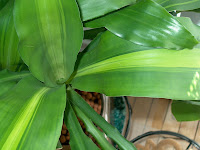Resembling a corn plant with broad leaves marked with a yellow stripe down the center, this striking plant is one of the most popular Dracaenas, widely-grown inside homes, offices and public spaces. Dracaena fragrans �Massangeana�, native to West Africa, Tanzania and Zambia, is a tolerant and versatile specimen capable of growing as high as ten feet indoors when properly cared for. But don�t punch holes in your ceiling yet; this is a slow-growing plant that will take years to reach its full height.
Although able to survive in dimly lit areas, a corn plant prefers bright light. Choose a location that offers medium to bright light or some early morning or late afternoon sun. Always protect against the hot rays of the summer�s midday sun. Like most of its cousins, this lovely Dracaena will manage reasonably well in low light conditions if you must place it there, but by placing it in a brighter location, you�ll be rewarded with well-defined variegated leaves and faster growth. Already slow-growing, Dracaena fragrans �Massangeana� will grow even more slowly in darker spaces.
It is absolutely essential that you use a fast-draining, porous soil for this plant that is highly-prone to root rot. In addition, the root system of a Dracaena fragrans �Massangeana� is surprisingly small, so the plant should be grown in a small pot. Water thoroughly only when the medium is fairly dry; reduce watering during the colder months. This is a wonderful candidate for the hydroculture system. Transplanting from soil to clay pebbles is easy; there are very few, if any, visible signs of stress. There may be a loss of some lower leaves and slight wilting, but not much more than that. Keep the plant warm during the conversion and increase humidity. The first glimpse of water roots can begin as early as two weeks or as late as one month, rarely more.
Part of the appeal of many Dracaenas, this one included, is that they can tolerate dry air better than most indoor plants. But the preference is higher levels of humidity. Air that is too dry will lead to brown leaf tips and susceptibility to infestations, especially from spider mites. There are many ways that you can increase the humidity in your home, in individual rooms or around your plants. A few things you can do include: pebble trays, double potting, grouping, humidifiers.
This is not a heavy feeder, so go easy on the fertilizer. I�d suggest giving your plant a dose of liquid fertilizer no more than once a month, or even once every two months, during the spring and summer seasons. I�d even go so far as suggesting that you dilute that mixture to half recommended strength. Over-fertilizing can cause damage. If you�re not sure whether you should feed or not, err on the side of caution and feed very little. Do not feed during the late fall and throughout the winter.
Average household temperatures are fine. Make sure you shield this plant from any type of cold. These warm-weather lovers are extremely sensitive to cold drafts and chilly temperatures. Is your plant sitting in a draft? Do you have it on a cold windowsill? Is it near patio doors that are opened throughout the day, causing the plant to get hit by cold air constantly? Are the leaves touching cold glass? Is it located in a room where you lower the thermostat significantly? Is it in front of a window that you open daily for fresh air � in the middle of winter? If your plant is placed anywhere where cold air hits it, move it. Correct any situations that have the potential to cause cold damage or your Dracaena fragrans �Massangeana� will deteriorate rapidly.
Dust will accumulate on the leaves; this can clog pores and make it harder for the plant to breathe. Your Dracaena fragrans �Massangeana� will benefit from an occasional cleaning of the foliage. If your plant is not too big to lug around, place it in the shower and hose it down. You can put aluminum foil over the top of the soil to avoid saturating it and making a mess. Smaller plants can be rinsed in a kitchen sink under running water or with a spray nozzle. Plants that are too big and heavy to move around can have their leaves wiped clean with a wet sponge. No matter what type of method you choose, pay particular attention to the undersides of leaves where pests reside. And make sure to carry out this type of grooming during the morning hours so the leaves have enough time to dry before nightfall. Leaving a plant wet at night can encourage or invite fungal/disease problems.
This is one of the most tolerant and adaptable members of the Dracaena group. With proper care, Dracaena fragrans �Massangeana� will grace your home with its attractive foliage for years.
Friday, 8 April 2011
Subscribe to:
Post Comments (Atom)


0 comments:
Post a Comment